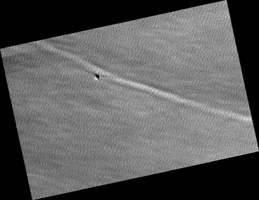
Map Projected Browse Image
Click on the image for larger versionThis locale was targeted to a bright, bow-shaped marking visible in a summertime image from MRO's Context Camera. Our HiRISE image reveals a crater near the streak, perhaps from an impact event, although now too degraded to be certain of its origin.
This image also shows a lacy network of many fine channels associated with jets in the subliming carbon dioxide of the springtime. The bright streak might be due to topographic shading, although an anaglyph will help us determine that for certain. If it is topographic, then this portion of the layered deposits may have been folded under compressional stresses, perhaps from gravitational slumping.
This is a stereo pair with ESP_032226_0910.
The University of Arizona, Tucson, operates HiRISE, which was built by Ball Aerospace & Technologies Corp., Boulder, Colorado. NASA's Jet Propulsion Laboratory, a division of the California Institute of Technology in Pasadena, manages the Mars Reconnaissance Orbiter Project and Mars Science Laboratory Project for NASA's Science Mission Directorate, Washington.

